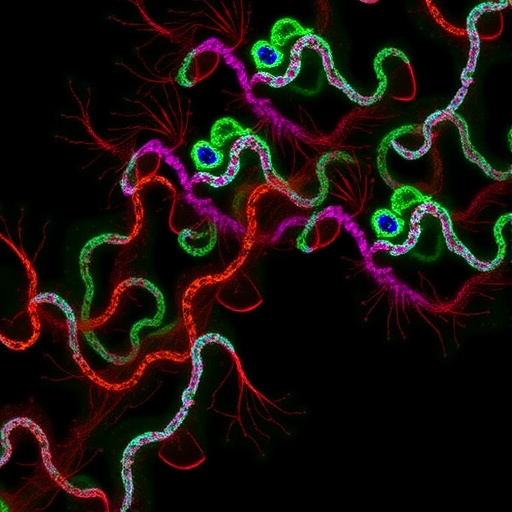
In a groundbreaking study that could transform our understanding of metabolic liver diseases, researchers have unveiled a novel biochemical modification that plays a crucial role in mitigating the progression of Metabolic Associated Steatotic Liver Disease (MASLD). MASLD, a condition increasingly recognized for its global health impact, is characterized by excessive fat accumulation in liver cells that can escalate to severe liver dysfunction and even cirrhosis. Until now, therapeutic options have been limited, largely due to an incomplete understanding of the molecular pathways involved. This new research highlights the crotonylation of isocitrate dehydrogenase 1 (IDH1) as a pivotal mechanism that enhances the tricarboxylic acid (TCA) cycle, providing a protective effect against MASLD progression.
The TCA cycle, often referred to as the Krebs cycle or citric acid cycle, is a central metabolic pathway through which cells generate vital energy molecules like ATP. In the context of liver metabolism, efficient TCA cycle functioning is essential not only for energy homeostasis but also for managing lipid accumulation and oxidative stress—two major factors implicated in MASLD pathogenesis. The study’s authors reveal that post-translational modification of IDH1 by crotonylation substantially boosts its enzymatic activity, thereby accelerating the TCA cycle flux and mitigating the metabolic derangements associated with fat-laden hepatocytes.
Crotonylation is a form of histone modification where a crotonyl group is added to lysine residues on proteins. Traditionally studied in the context of epigenetic regulation, crotonylation’s emerging role in regulating metabolic enzymes represents a paradigm shift in how biochemical modifications influence cellular metabolism. The research team demonstrated that crotonylation of IDH1 specifically enhances the enzyme’s ability to catalyze the oxidative decarboxylation of isocitrate to α-ketoglutarate, an essential step in the TCA cycle that fuels downstream reactions crucial for cellular energy production.
Mechanistic investigations revealed that crotonylated IDH1 undergoes structural changes that increase substrate affinity and catalytic turnover. This fine-tuning of enzymatic activity facilitates improved mitochondrial function and reduces the accumulation of metabolic intermediates that are otherwise dysregulated in MASLD. By maintaining a more robust mitochondrial metabolic flux, crotonylation indirectly curbs lipotoxicity and reduces the oxidative stress burden on hepatocytes, two interrelated processes that aggravate liver injury in MASLD.
Utilizing advanced proteomic techniques, the researchers quantified crotonylation levels in liver tissues derived from MASLD patients and corresponding animal models. Intriguingly, they observed a significant depletion of crotonylation marks on IDH1 in diseased states, correlating with diminished enzyme activity and perturbed TCA cycle dynamics. This discovery suggests that impaired crotonylation could be a contributing factor to the metabolic dysfunction characterizing MASLD and offers a promising biomarker for disease progression.
To further validate their findings, the team engineered mouse models with liver-specific mutations that either mimic constitutive crotonylation or prevent this modification on IDH1. Mice exhibiting enhanced IDH1 crotonylation were remarkably protected from high-fat diet-induced steatosis and subsequent liver inflammation. These animals showed improved biochemical parameters, decreased lipid accumulation, and reduced histopathological signs of MASLD, underscoring the therapeutic potential of modulating crotonylation pathways.
Beyond the liver-specific effects, this discovery may have broader implications for systemic metabolism. Given that the TCA cycle is a central hub for energy metabolism across tissues, augmenting crotonylation of IDH1 or similar metabolic enzymes could represent a novel strategy for treating metabolic syndromes that extend beyond primary liver disease. The research opens up new vistas for drug development aimed at enhancing endogenous protein modifications rather than directly targeting enzyme active sites, a method that could yield higher specificity with fewer adverse effects.
Underlying these biological insights, the team employed innovative biochemical assays and cutting-edge mass spectrometry to trace crotonylation dynamics in living cells under varying metabolic conditions. They revealed that nutrient status and metabolic stress modulate crotonylation levels, suggesting this modification serves as a responsive regulatory mechanism adapting enzymatic activity to cellular energy demands. Such findings highlight the exquisite control cells exert over metabolic fluxes via reversible protein modifications, reshaping current models of metabolic regulation.
An exciting aspect of the research involves the interplay between crotonylation and other post-translational modifications affecting IDH1, such as acetylation and phosphorylation. The complex crosstalk between these modifications appears to fine-tune IDH1’s function in a context-dependent manner, potentially integrating multiple signaling pathways related to nutrient sensing and stress response. Future work disentangling these interactions could provide a comprehensive framework for understanding metabolic enzyme regulation.
The clinical implications of this work are profound. With MASLD on the rise globally due to increasing prevalence of obesity and type 2 diabetes, the identification of modifiable biochemical pathways offers a fresh avenue for therapeutic intervention. Current drugs targeting lipid metabolism or inflammation have had limited success, but targeting crotonylation pathways might circumvent these obstacles by restoring fundamental energy metabolism. Moreover, this approach has the advantage of enhancing endogenous metabolic capacity rather than imposing exogenous interventions that might disrupt systemic balances.
Furthermore, the study’s insights into mitochondrial function shed light on how metabolic flexibility—that is, the ability of cells to adapt energy production pathways in response to diet and environment—can be manipulated for therapeutic benefit. Mitochondrial dysfunction is a hallmark not only of MASLD but many chronic diseases, including neurodegeneration and cancer. Therefore, crotonylation-modulated IDH1 activity might emerge as a universal target in diverse pathologies involving mitochondrial impairment.
Given these promising outcomes, the study paves the way for clinical exploration of agents capable of modulating protein crotonylation. Small molecules that enhance crotonyl-CoA availability or inhibit de-crotonylases could serve as lead compounds for drug development. These therapeutic strategies would differ fundamentally from enzyme inhibitors or receptor modulators, operating instead by augmenting beneficial protein modifications to restore physiology.
This research also prompts a reevaluation of crotonylation’s role in broader epigenetic and metabolic contexts. Its dual role in regulating chromatin structure and enzymatic activity suggests it may coordinate gene expression with metabolic adaptation—a vital process during cellular stress, differentiation, or disease. Deciphering this coordination will have far-reaching implications for biology and medicine.
In sum, the crotonylation of IDH1 represents a vital metabolic checkpoint controlling the progression of MASLD through enhancement of the TCA cycle. By illuminating this molecular mechanism, Liu et al. offer a groundbreaking perspective that bridges epigenetic modification and metabolic control. Their work not only elucidates a novel biological principle but also carves a path toward innovative therapies for one of the most pressing liver disorders of our time.
Subject of Research:
The biochemical modulation of IDH1 via crotonylation and its impact on Metabolic Associated Steatotic Liver Disease (MASLD) progression through enhancement of the tricarboxylic acid cycle.
Article Title:
Crotonylation of IDH1 alleviates MASLD progression by enhancing the TCA cycle.
Article References:
Liu, S., Ji, Y., Wei, L. et al. Crotonylation of IDH1 alleviates MASLD progression by enhancing the TCA cycle. Nat Commun 16, 7961 (2025). https://doi.org/10.1038/s41467-025-62731-9
Image Credits: AI Generated
Tags: biochemical modification in metabolismenzymatic activity in liverfatty liver disease treatmentIDH1 crotonylationliver metabolism and energyMASLD progressionmetabolic associated steatotic liver diseasemetabolic liver diseasesmetabolic pathways in liver healthoxidative stress managementpost-translational modificationsTCA cycle enhancement




